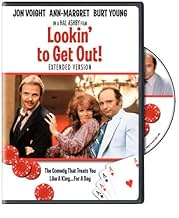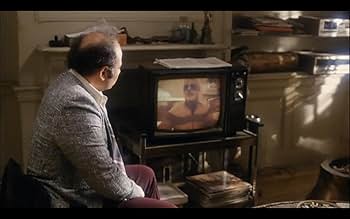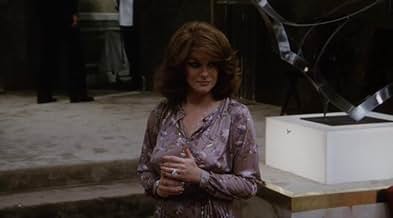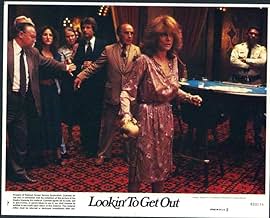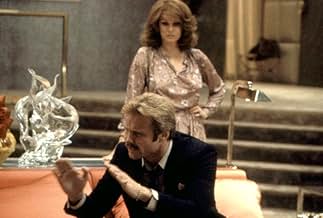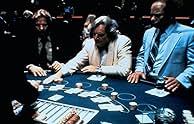IMDb-BEWERTUNG
5,1/10
956
IHRE BEWERTUNG
Füge eine Handlung in deiner Sprache hinzuAlex has had a good day at the track, a bad night at the poker game and hell have a worse time if the guys he owes catch up with him. So Alex and go-along pal Jerry split for Las Vegas...Alex has had a good day at the track, a bad night at the poker game and hell have a worse time if the guys he owes catch up with him. So Alex and go-along pal Jerry split for Las Vegas...Alex has had a good day at the track, a bad night at the poker game and hell have a worse time if the guys he owes catch up with him. So Alex and go-along pal Jerry split for Las Vegas...
Jude Farese
- Harry
- (as Jude Ferrese)
Larry Flash Jenkins
- Parking Attendant - Brings Up the Car
- (as Larry 'Flash' Jenkins)
Hank Robinson
- Poker Player
- (as Henry Robinson)
Sig Frohlich
- Poker Game Dealer
- (as Sigmond Frohlick)
Empfohlene Bewertungen
Before I get into my critique of "Lookin' To Get Out", I feel I should mention that I saw the original theatrical cut of the movie via finding an old VHS release of the movie. Supposedly, the DVD release of this movie runs 15 extra minutes and supposedly improves the movie. That may be the case, but from what I saw, I can't see any extra footage making a big improvement of the mess that I saw. True, the DVD cut may explain a number of unanswered questions the original cut had, like why one character has bandages over one of his eyes. But the movie would still have a slow and plot less feel - it frequently feels that the actors are making it up as they go along. And while I think Voight and Young are talented actors, they give extremely annoying performances. The only thing that survives intact is the performance by Bert Remsen as the professional gambler - he's colorful, and commands the screen in his scenes. But even he can't save the movie enough to make it worth watching.
I thought this film was excellent! I saw the extended version on DVD so uncertain what the clipped version looks like.
Jon Voight is superlative as the annoying wise guy gambler. Burt Young doesn't appear to be acting as the NYC street wise buddy - he is that good or at least well cast. Ann-Margret nails it as the old girl-friend who can't quite get Voight's character Alex out of her system. She is smoldering every time she is on screen and she really keeps the viewer enthralled with all the male actors vying for attention. Her extended kiss as Patti Warner with Alex will jolt male and female viewers alike with its tenderness and anticipation!
Should be required viewing for anyone with, or knows someone with a gambling addiction!
Really combines some of the best elements of Ocean's 11, The Sting and Don Quixote. Don't miss the last 15 minutes to see who is conning who.
The scene with real life father Jon Voight and daughter Angelina Jolie is not to be missed as it came off surreal to me. Watch and see what I mean.
Jon Voight is superlative as the annoying wise guy gambler. Burt Young doesn't appear to be acting as the NYC street wise buddy - he is that good or at least well cast. Ann-Margret nails it as the old girl-friend who can't quite get Voight's character Alex out of her system. She is smoldering every time she is on screen and she really keeps the viewer enthralled with all the male actors vying for attention. Her extended kiss as Patti Warner with Alex will jolt male and female viewers alike with its tenderness and anticipation!
Should be required viewing for anyone with, or knows someone with a gambling addiction!
Really combines some of the best elements of Ocean's 11, The Sting and Don Quixote. Don't miss the last 15 minutes to see who is conning who.
The scene with real life father Jon Voight and daughter Angelina Jolie is not to be missed as it came off surreal to me. Watch and see what I mean.
It is a widespread practice: it is enough that a false authority (most entertainment reporters who are no film critics, only regular spectators) dislikes something, for a choir of followers to repeat his opinion and create undeserved bad reputation for a cultural product. Such is the case of (among others) «Born to Win», «The Hotel New Hampshire», and «Lookin' to Get Out», all the three curiously made in the 1980s, a challenging time in the history of the United States, under Ronald Reagan's dominant image.
Respectively directed by Czech Ivan Passer, British Tony Richardson, and American Hal Ashby, the three films had something valuable to say about US individuals, institutions, and customs: be it the disintegration of the couple due to drug abuse, the dysfunction of nuclear families, consumerism, and a certain vulgarity that may describe Las Vegas too well. None of the three films is a masterpiece, but they rise above the low scores and bad opinions that surround them.
In particular, «Lookin' to Get Out» (the director's cut) did not diminish at all the great admiration I have for Ashby, one of the most underrated American filmmakers, with a magnificent body of work that includes «The Landlord», «Harold and Maude», «The Last Detail», «Shampoo», «Bound for Glory», «Coming Home», «Being There», and the documentary «Let's Spend the Night Together», all containing his privileged perception of his fellow Americans and their cultures. Anyone who has ever made any two titles of those, has the liberty to make lesser films as «8 Million Ways to Die» or «Lookin' to Get Out», which are not bad at all.
Written by Al Schwartz and Jon Voight, «Lookin' to Get Out» is a typical American film comedy drama about gambling buddies, prostituted women, exaggerated bad taste, and a peculiar cultural way of reacting to troubles, stuff that has being the basis of dozens of dramatic comedies, much worse than this. Voight and Burt Young play friends who are trying to get out of trouble, when they have to pay 10 thousand dollars in 24 hours, and the only solution they come up with is going to gamble in Las Vegas, where Ann-Margret crosses their path with a different agenda.
The plot, which does not aspire for an award to originality, benefits however from the performances of the central cast (Voight, Young, Ann-Margret, Bert Remsen and Richard Bradford), and the contribution of a group of unknown faces that add weight to the story being told; from maestro Haskell Wexler's cinematography and mainly -in my opinion- from Ashby's hand, from his subtle and affectionate style to capture the fragility of the demented characters, to handle with caution the grotesque and violent, but without suppressing those events and attitudes that offend human dignity, day after day.
If you find a copy of Ashby's cut, do not miss it. You will add another title to the gallery of good performances by Voight, Ann-Margret and Young, your appreciation of Ashby will not be affected a bit (unless you have overrated «Harold and Maude») and, as a bonus, you'll see Angelina Jolie (Voight) at six, playing her talented father's little girl. The extended version edition includes a reunion of the actors, who evoke Ashby's memories and his working method.
Respectively directed by Czech Ivan Passer, British Tony Richardson, and American Hal Ashby, the three films had something valuable to say about US individuals, institutions, and customs: be it the disintegration of the couple due to drug abuse, the dysfunction of nuclear families, consumerism, and a certain vulgarity that may describe Las Vegas too well. None of the three films is a masterpiece, but they rise above the low scores and bad opinions that surround them.
In particular, «Lookin' to Get Out» (the director's cut) did not diminish at all the great admiration I have for Ashby, one of the most underrated American filmmakers, with a magnificent body of work that includes «The Landlord», «Harold and Maude», «The Last Detail», «Shampoo», «Bound for Glory», «Coming Home», «Being There», and the documentary «Let's Spend the Night Together», all containing his privileged perception of his fellow Americans and their cultures. Anyone who has ever made any two titles of those, has the liberty to make lesser films as «8 Million Ways to Die» or «Lookin' to Get Out», which are not bad at all.
Written by Al Schwartz and Jon Voight, «Lookin' to Get Out» is a typical American film comedy drama about gambling buddies, prostituted women, exaggerated bad taste, and a peculiar cultural way of reacting to troubles, stuff that has being the basis of dozens of dramatic comedies, much worse than this. Voight and Burt Young play friends who are trying to get out of trouble, when they have to pay 10 thousand dollars in 24 hours, and the only solution they come up with is going to gamble in Las Vegas, where Ann-Margret crosses their path with a different agenda.
The plot, which does not aspire for an award to originality, benefits however from the performances of the central cast (Voight, Young, Ann-Margret, Bert Remsen and Richard Bradford), and the contribution of a group of unknown faces that add weight to the story being told; from maestro Haskell Wexler's cinematography and mainly -in my opinion- from Ashby's hand, from his subtle and affectionate style to capture the fragility of the demented characters, to handle with caution the grotesque and violent, but without suppressing those events and attitudes that offend human dignity, day after day.
If you find a copy of Ashby's cut, do not miss it. You will add another title to the gallery of good performances by Voight, Ann-Margret and Young, your appreciation of Ashby will not be affected a bit (unless you have overrated «Harold and Maude») and, as a bonus, you'll see Angelina Jolie (Voight) at six, playing her talented father's little girl. The extended version edition includes a reunion of the actors, who evoke Ashby's memories and his working method.
My review was written in September 1982 after a Columbus Circle screening.
Hal Ashby's "Lookin' to Get Out" is an ill-conceived vehicle for actor (and co-writer) Jon Voight to showcase his character comedy talents in a loose, semi-improvised environment. Harking back uncomfortably to the buddy pictures of a decade ago (particularly the Elaine May flop for Paramount "Mikey and Nicky"), the film only gels intermittently and despite its star names faces a grim commercial future.
Its tortuous production history saw "Lookin'" enter principal photography in May 1980 as a Lorimar production for United Artists release, later acquired in a package deal by Paramount. Five months of shooting was interrupted by the actors' strike, with reshooting and re-editing to follow. End product reflects little of the $17,000,000-plus negative cost on screen in this intimate tale of two vagabond gamblers.
Akex (Jon Voight) and Jerry (Burt Young) are the central figures, who flee New York to Las Vegas to escape thugs Harry (Jude Farese) and Joey (Alan Keller) whose $10,000 Alex has dropped in a poker game. In an increasingly contrived and unconvincing series of coincidence and turns of luck, duo set up shop in the "Dr. Zhivago" suite of the MGM Grand Hotel and use a false identity to obtain unlimited credit from the casino.
Return of casino owner Bernie Gold (Richard Bradford) ends their free-loading, but not before they have staked an ex-gambler (now a waiter at the hotel) Smitty (Bert Remsen) to a high-stakes blackjack game with ironic results.
Occasionally amusing, picture often has the feel of being improvised, with director Ashby giving Voight a loose rein to inject physical business and odd dialog into a scene. Interplay between Voight and Young is the film's raison d'etre, with each return to functional plot development or "surprise" twist coming off as artificial and annoying.
For example -star-billed Ann-Margret is injected (and written out at will) into the film as Alex's ex-girlfriend who just happens to be Gold's current flame, and in a preposterous curtain revelation by Gold, the mother of Alex's daughter which Alex has never met. Instead of farcical, this scene is irritating since, as usual, the viewer is way ahead of the screenplay. Oft-underlined theme of the joys and perils of acting upon impulse is negated by the unconvincing workings of fate.
Sporting a distracting no-bra look Ann-Margret is decorative but has no character to play. Remsen is effective, though his presence recalls an earlier (and far better) film he made in the same gambling milieu, Robert Altman's "California Split". Stars Voight and Young are an entertaining team, but presented in an untenable vehicle.
Tech credits are fine, including shameless plugging for the MGM leisure palace and its entertainment shows (particularly Siegfried and Roy's magic acts). Johnny Mandel's electronic rock score covers the awkward lapses between scenes, but without that bare musical bridge the film seems like out-takes of actors "winging it".
Hal Ashby's "Lookin' to Get Out" is an ill-conceived vehicle for actor (and co-writer) Jon Voight to showcase his character comedy talents in a loose, semi-improvised environment. Harking back uncomfortably to the buddy pictures of a decade ago (particularly the Elaine May flop for Paramount "Mikey and Nicky"), the film only gels intermittently and despite its star names faces a grim commercial future.
Its tortuous production history saw "Lookin'" enter principal photography in May 1980 as a Lorimar production for United Artists release, later acquired in a package deal by Paramount. Five months of shooting was interrupted by the actors' strike, with reshooting and re-editing to follow. End product reflects little of the $17,000,000-plus negative cost on screen in this intimate tale of two vagabond gamblers.
Akex (Jon Voight) and Jerry (Burt Young) are the central figures, who flee New York to Las Vegas to escape thugs Harry (Jude Farese) and Joey (Alan Keller) whose $10,000 Alex has dropped in a poker game. In an increasingly contrived and unconvincing series of coincidence and turns of luck, duo set up shop in the "Dr. Zhivago" suite of the MGM Grand Hotel and use a false identity to obtain unlimited credit from the casino.
Return of casino owner Bernie Gold (Richard Bradford) ends their free-loading, but not before they have staked an ex-gambler (now a waiter at the hotel) Smitty (Bert Remsen) to a high-stakes blackjack game with ironic results.
Occasionally amusing, picture often has the feel of being improvised, with director Ashby giving Voight a loose rein to inject physical business and odd dialog into a scene. Interplay between Voight and Young is the film's raison d'etre, with each return to functional plot development or "surprise" twist coming off as artificial and annoying.
For example -star-billed Ann-Margret is injected (and written out at will) into the film as Alex's ex-girlfriend who just happens to be Gold's current flame, and in a preposterous curtain revelation by Gold, the mother of Alex's daughter which Alex has never met. Instead of farcical, this scene is irritating since, as usual, the viewer is way ahead of the screenplay. Oft-underlined theme of the joys and perils of acting upon impulse is negated by the unconvincing workings of fate.
Sporting a distracting no-bra look Ann-Margret is decorative but has no character to play. Remsen is effective, though his presence recalls an earlier (and far better) film he made in the same gambling milieu, Robert Altman's "California Split". Stars Voight and Young are an entertaining team, but presented in an untenable vehicle.
Tech credits are fine, including shameless plugging for the MGM leisure palace and its entertainment shows (particularly Siegfried and Roy's magic acts). Johnny Mandel's electronic rock score covers the awkward lapses between scenes, but without that bare musical bridge the film seems like out-takes of actors "winging it".
Seven stars. A weak seven, but good enough to round up. Hal Ashby
had, possibly, the best six-consecutive film run in history from Harold and
Maude through Being There. This film clearly does not match that amazing run,
but it's still a lot of fun. Jon Voigt, an actor I've been a fan of for 50
years now, turns in an excellent performance as a more-wily-than-smart gambler
trying to square a big debt. Ann-Margret does fine as his ex, who figures out
he's running a con at the Vegas spot where she now works. But for my money,
the show is stolen by Burt Young. He did tons of movie and TV work, and was a
tremendous actor. But he was too dumpy looking to be a star. In a career of
character parts, this was one of his biggest shots, and he just nailed the loyal, not
as dumb as everyone thinks, sidekick.
Ashby's career as a director was pretty short, and he really faded from prominence in the last few years of his life. But he was still making quirky, intelligent, entertaining films. The film from his big six that is closest to this is probably The Last Detail. If you liked that one, take a look a this. 20 September 2022.
Ashby's career as a director was pretty short, and he really faded from prominence in the last few years of his life. But he was still making quirky, intelligent, entertaining films. The film from his big six that is closest to this is probably The Last Detail. If you liked that one, take a look a this. 20 September 2022.
Wusstest du schon
- WissenswertesDebut theatrical feature film of Angelina Jolie, who appeared in the movie at age five.
- Alternative VersionenAn extended version of the film was released on DVD on June 30, 2009. It runs 15 minutes longer than the theatrical cut, at 120 minutes.
- VerbindungenFeatured in At the Movies: Dueling Critics (1983)
- SoundtracksLookin' to Get Out
Music & Lyrics by Johnny Mandel, George Doering & Jo Ellen Doering
Sung by Tommie Lee Bradley, David Palmer, Paul Delf, Mark Burger
Top-Auswahl
Melde dich zum Bewerten an und greife auf die Watchlist für personalisierte Empfehlungen zu.
- How long is Lookin' to Get Out?Powered by Alexa
Details
Box Office
- Budget
- 17.000.000 $ (geschätzt)
- Bruttoertrag in den USA und Kanada
- 946.461 $
- Eröffnungswochenende in den USA und in Kanada
- 528.559 $
- 10. Okt. 1982
- Weltweiter Bruttoertrag
- 946.461 $
Zu dieser Seite beitragen
Bearbeitung vorschlagen oder fehlenden Inhalt hinzufügen



